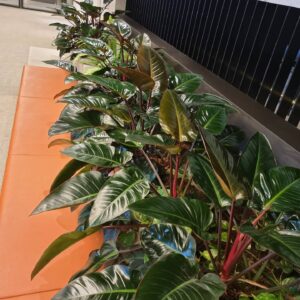
What makes a fertiliser suitable for application in interior plantscapes?
By Gabrielle Stannus
We speak to industry experts to find out the pros and cons of some fertilisers commonly used indoors, including controlled release, water-soluble, foliar and organic applications, and find out why their N-P-K ratio is so important for plant health.
Controlled release and water-soluble fertilisers
“Controlled release fertilisers (CRF) and water-soluble fertilisers (WSF) are made for different purposes. CRF is ideal for application in pots, where one application of fertiliser will feed the plants continuously for between 3 months and 18 months, depending on the product applied. CRF significantly reduces labour requirements when looking after plants in interior plantscapes,” says Dr Samuel Stacey, a Technical Manager with ICL. ICL manufacture and supply a range of fertilisers used in interior plantscapes, including controlled release (Osmocote) and water-soluble fertilisers (Peters, Universol). “Water soluble fertilisers are used frequently in green walls and hydroponic situations. They are not ideal for individual pot plants, for example in an office environment, because the fertiliser would require frequent reapplication,” explains Dr Stacey, “They are usually applied through fertigation systems and need to be frequently monitored and fertiliser reapplied. More technical know-how is required when using them.”
According to Robert Megier, ICL’s Turf & Ornamental Regional Manager, monitoring the electrical conductivity (EC) of solutions used in fertigated green wall applications is critical to maintaining plant health. “Electrical conductivity changes over time due to plant transpiration rates and use of water,” says Robert, “A plant in a green wall in a dark spot indoors will have a very low nutrient requirement compared with a plant in a green wall on a building exterior. If you were to over-apply any fertiliser and you got a build-up of total salts (elevated EC) in your interior green wall, those elevated salts could be translocated to the leaf tips and margins, resulting in tip burn or necroses. This symptom however can also be caused by over- or under-watering so it can be hard to diagnose.”

Solubility and compatibility with different water types are also key considerations when choosing a water-soluble fertiliser. For example, if using hard water high in calcium and magnesium, then Dr Stacey recommends using a fertiliser that does not have additional calcium and magnesium. “Plants need different elements like phosphorus, calcium and magnesium. However, if you mix them together in the same tank, you can get precipitation where they react together and form a solid, meaning they are not solubilised in the water. So, the plants do not actually see the nutrient,” says Dr Stacey. He says that green wall fertigation systems with multiple tanks allow interior plantscapers to easily split different types of nutrients to avoid these types of interactions, or they may choose what he calls a ‘one-tank’ fertiliser, which has been specifically developed for compatibility between nutrients.
Foliar applications and organic fertilisers
“Foliar applications are only useful to apply small amounts of fertilisers and are therefore usually reserved for trace elements, when application directly to the soil is not possible. Plant roots are highly efficient at absorbing nutrients whereas plant leaves can only handle very dilute nutrient solutions, otherwise leaves will mark or burn. Additionally, foliar applications do not have any residual benefit and multiple applications are usually required to get a significant plant response. For these reasons, foliar applications are probably the least efficient way to apply nutrients to indoor plants,” claims Dr Stacey. Foliar applications also increase the likelihood of run-off onto floors, carpets and furnishings.

If using foliar applications, Michael Harding (Interior Plantscape Association member), recommends spraying close to the foliage and then wiping it down with a clean cloth. Michael is a Director of EcoGro. If you are considering the use of organic fertilisers, Michael says to ensure that the product you choose does not smell. Many organic fertilisers include bone meal, dried blood, fish emulsion, and other components that give off a noticeable and undesirable odour, with interior plantscapers saying they may be a poor choice in an enclosed indoor space1[GS1] .
N-P-K ratio
“N-P-K proportions are so important when it comes to choosing the right fertiliser,” adds Michael, “The three numbers that you see on a fertiliser label tell you what proportion of each macronutrient the fertiliser contains. Nitrogen is essential in the formation of protein, and protein makes up much of the tissues of most living things. Phosphorus (P) stimulates root growth, helps plants set buds and flowers, and produce seeds. It also helps plants use other nutrients more efficiently and helps turn energy from the sun into usable energy for your plants. Potassium (K) helps plants grow strong stems and keep them growing fast. Plants lacking in potassium do not have enough energy to grow properly grow, their roots are not well formed, they have weak stems, the edges of older plant leaves appear burned, and potassium deficient plants cannot regulate and use water efficiently.”
Dr Stacey says that plants normally require higher levels of nitrogen and potassium than phosphorus. “Hence, an N-P-K ratio of 4-1-3 or 6-1-4 would work well for most indoor plants,” concludes his colleague, Robert.
Gabrielle Stannus
Inwardout Studio
M: 0400 431 277
E: gabrielle@inwardoutstudio.com
Board Member, Interior Plantscape Associationwww.interiorplantscape.asn.au
